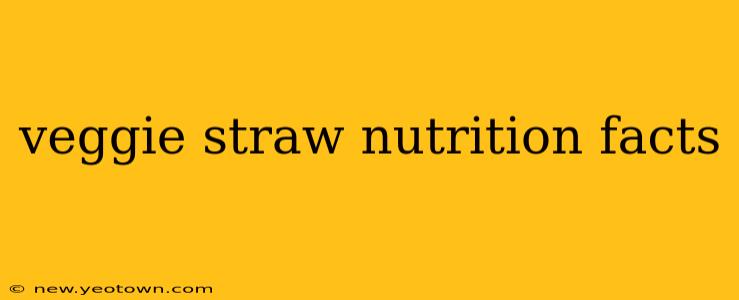Veggie straws. The name conjures images of a healthy, crunchy snack, a guilt-free indulgence. But how accurate is that image? Let's delve into the nutritional facts of veggie straws, exploring what makes them tick (and maybe a few things that might surprise you).
My journey into the world of veggie straw nutrition began with a simple question: are they as healthy as they seem? This led me down a rabbit hole of ingredient lists, nutritional panels, and even some surprising comparisons to other popular snacks. What I found was fascinating, and I'm excited to share my discoveries with you.
What are the main ingredients in veggie straws?
The primary ingredients in veggie straws typically include vegetables like potatoes, carrots, and sometimes corn. However, the processing involved significantly alters the nutritional profile. While they start with vegetables, the end product is significantly different. This is where things get interesting. The processing often involves adding things like vegetable oil, salt, and various spices. The exact proportions vary depending on the brand and flavor. It's important to remember that the "veggie" in veggie straw refers to the origin of some of the ingredients and not necessarily a reflection of the final product's overall nutritional composition.
How many calories are in a serving of veggie straws?
A typical serving of veggie straws (around 1 ounce or 28 grams) usually contains around 140-160 calories. This caloric count can fluctuate based on flavor and brand. It's always advisable to check the specific nutritional information printed on the package you're consuming. The calorie count isn't excessively high compared to other snack options, but it's not negligible either.
Are veggie straws a good source of vitamins and minerals?
While veggie straws begin with vegetables, the processing significantly reduces their vitamin and mineral content. Don't expect a massive dose of essential nutrients. They do offer some vitamins and minerals, but they're not a primary source. Compared to eating fresh vegetables, the nutritional benefit is considerably less.
How much fat, sodium, and carbohydrates are in veggie straws?
This is where the nutritional profile becomes more complex. Veggie straws typically contain a moderate amount of fat, primarily from vegetable oils. The sodium content can be relatively high, a concern for individuals watching their salt intake. Carbohydrates are the primary macronutrient, mostly in the form of simple carbohydrates. Understanding these macro breakdowns is key to fitting veggie straws into a balanced diet.
Are veggie straws a healthy snack option?
This is the million-dollar question. The answer is nuanced. Veggie straws aren't inherently unhealthy, but they're not a powerhouse of nutrition either. They can be part of a balanced diet in moderation. However, over-consumption can contribute to excess calorie, sodium, and fat intake. The best approach is mindful consumption and understanding their place within a broader dietary context. Think of them as an occasional treat rather than a staple of a healthy diet.
Are there healthier alternatives to veggie straws?
Absolutely! Many healthier snack options exist, such as fresh vegetables with hummus, air-popped popcorn, or whole-grain crackers with cheese. Choosing these alternatives ensures you receive a greater nutritional benefit while satisfying your craving for a crunchy snack.
What are the different types of veggie straws available?
Various veggie straw brands and flavors exist. Some offer variations on the original recipe, incorporating different seasonings and spices. Always check the nutritional information on individual packages, as the composition can vary between brands and even between flavors within the same brand.
In conclusion, veggie straws offer a crunchy, satisfying snack experience, but their nutritional value is limited compared to whole, unprocessed vegetables. Enjoy them occasionally, but prioritize whole, nutritious foods as the foundation of a balanced and healthy diet. Remember, informed choices are the cornerstone of healthy eating!

